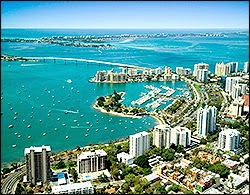NAPLES, Fla. – Dec. 17, 2014 – Trying to ignore the cameras focused on them from the balcony, they sipped chardonnay in plastic cups, schmoozed and whispered behind each other's backs.
Then the handpicked cast of six high-powered Naples real estate agents mingled with a crowd of about 300 local housing industry bigwigs, potential buyers and curious looky-loos at an open-house party at a $23 million home for sale in Port Royal.
It was all part of a pilot for a new reality real estate show, the brainchild of ITZ studio founder Chuck Ardezzone, called Million Dollar Listing Naples: Billionaire's Coast.
Ardezzone said the show is the first in a series that he expects will begin in
Naples and eventually creep up the coast to Ft. Myers Beach, Sanibel Island and possibly Venice.
"We're not doing the lower-priced million-dollar homes," he said. "We're focusing on the upper echelons."
Because of its high concentration of wealthy seasonal and permanent residents, Naples was picked as the spot to create the "sizzle reel" that Ardezzone will try to sell to BRAVO or HGTV.
He's also gathering sponsors, with an eye to airing the show on a local station starting in early February. But he hasn't cut a deal yet.
Although television commercials are his bread-and-butter – he's produced more than 600 regionally at his 4,000-square-foot studio in Naples – Ardezzone has been busy creating more than 20 reality-show sizzle reels that he regularly pitches to television networks.
He's been successful selling four shows, the most notable being "Tobacco Wars," which was picked up by country network CMT.
Most recently, he produced "Paradise Coast Wives," based on the usual model of catfights among pampered wealthy women. It has aired locally but has yet to be picked up nationally.
Million Dollar Listing will be something different, he vowed, adding it will feature successful luxury real estate agents like Diana Frey and Chris Resop, a former professional baseball player.
"We don't want a trashy show," he said.
But no reality show is complete without drama. So will that include backstabbing arguments among agents competing for luxury listings?
Ardezzone, who's looking to residential brokerages for backing, says no – "unless it happens organically."
Instead, he expects to find the necessary tension in the give-and-take that happens when ego-driven wealthy sellers and buyers bicker, and brokers scramble to keep their big-ticket deals from falling apart.
Cast-member Jordan Delaney, an agent who specializes in luxury golf-course communities, agreed with that approach.
"There's enough that goes wrong during a day in real estate – you don't need to create more drama," he said.
Another cast member, Amanda Erwin, concurred, adding she recently saw a million-dollar deal fall through simply because the seller and buyer decided they didn't like one another.
"It's not always about the money," she said.
While there were no on-camera brawls at last week's four-hour pilot-show party, which was entertained by a guitarist and a ponytailed artist painting landscapes, some visitors still indulged in some off-camera griping.
Decked out in an ascot and red blazer, cast member Cliff Donenfeld griped about the commission for the buyer's agent, which he said was lower than normal for a luxury listing and could signal a seller who's really not serious about selling. "It's a red flag," he said.
Others complained about the potato chip and pizza spread, which listing agent Jackie May, a luxury agent for more than four decades, defended as being more fun than the usual shrimp-and-snow crab fare.
"It shows off the home's wood-fired pizza oven," she said, as she handed guests their swag: flashing Christmas ties and glow-stick necklaces.
While most guests gushed over the 9,000-square-foot mansion, complete with an elevator, bejeweled powder-room sink, and $400,000 worth of curlicue custom-made ironwork curving up the staircase, a few found fault.
"The master suite needs to be bigger in a house of this size," said retired Naples real estate agent Barbara Walsh. "And it needs more closet space."
Her boyfriend, oldies crooner Barry Newman, liked the house but wasn't too fond of the surrounding neighborhood.
"I don't like Port Royal," he said. "There's no place to park."
Copyright © 2014 the Naples Daily News (Naples, Fla.), June Fletcher. Distributed by Tribune Content Agency, LLC.






















